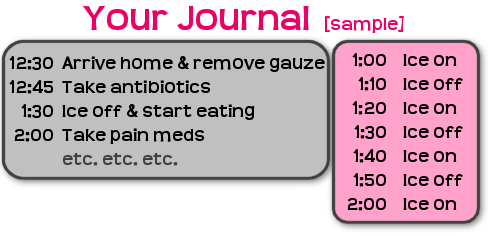Getting Your Wisdom Teeth Removed: Part 2
By Stephanie Lynn, age 24, Massachusetts
SDM Editor-in-Chief






Please be sure to read Part 1 of this article duet which was published in the November issue (SDM, "Getting Your Wisdom Teeth Removed 1"). Part 1 contains valuable information regarding preparation for your wisdom teeth surgery. In Part 2, I will take you through the surgery, what you should do immediately when you get home, the first few days of recovery, and how to eat well afterwards.
The Surgery
I chose to get conscious sedation since I've had other surgeries, I have anxiety towards needles, and I didn't want to remember the experience. You can get only the local anesthetic if you're having just one or two teeth pulled, but I recommend conscious sedation especially if it's two or more teeth. You can also be placed unconscious if you have severe anxiety, but I believe that you will be okay with the conscious sedation. During conscious sedation, you are technically awake for the entire surgery, but you won't remember anything - or much of anything - afterwards.
Because I received conscious sedation, I don't remember much of the surgery itself. After my name was called, I was led into the patient chair of one of the rooms. I was asked if I had any further questions or concerns, and I asked what I needed. You will most likely have a consultation with your dentist or oral surgeon days or weeks beforehand to discuss your personal situation during which you can ask questions. Meanwhile, one of the other assistants was setting items out on the counters in preparation. After electrodes were placed, the oral surgeon poked an IV needle into my right antecubital fossa, that is, the inside of my elbow joint. If you are only receiving a local anesthetic, then you will not need an IV. Conscious sedation can also be accomplished by inahaling gas, by means of a mask over your nose. The IV was one of my least favorite parts of the surgery, as I completely hate needles. I didn't have to deal with the discomfort of the IV for very long though. My doctor grabbed a second syringe and the meds quickly took effect. The next thing I remember was being walked into a neighboring room and placed on a cot to begin my recovery. I randomly started to tear up and the nurse mentioned that the sedation can make you feel weepy. I then realized that I had gauze in my mouth, which was making me feel "gaggy". She let me remove the gauze and gave me a few tissues. My memory at first was still fairly short. I then decided to take my mind off of the situation by scanning through a magazine. I only got through a few pages before I was handed a small glass of cranberry juice to drink. After a few minutes, the sedation meds wore off and I was on my way home.
If you were to choose the local anesthetic, as opposed to being "knocked out" or "put under", I'm sure the experience would be very different for you. I can only imagine the experience based on my past experiences with oral surgery. They will use needles to numb both sides of your mouth, cut your gums and create a "flap" to expose each tooth, and possibly drill and cut the tooth into two pieces. Then comes the pulling of the tooth and the stitching of the gums. This is something you most likely will not want to remember, so the conscious sedation for two or more teeth would be preferable. If you only have surgery for one tooth, you may be able to get by, but that is up to you.
Quick Tip: While you're in surgery, have your driver pick up any prescription meds that the doctor would like to place you on. This way, you can just head straight home after the surgery and start taking them. You won't want to wait in the car while your driver waits for them to be filled.
Recovery: Day 1
When your driver brings you home, make sure he or she or another trusted adult stays with you for the entire day. Once home, you should rest and eat. You will have your space all set up from the night before. I suggest that you eat as soon as you're able, especially if you received conscious or unconscious sedation (since you've been fasting) and/or if you'll be taking pain meds. Eating will help to keep your energy up over the next few days, which will in turn lessen the pain. You shouldn't take any type of pain med until you've eaten; otherwise, they will not be as effective or make you feel sick. I will cover some food options later in this article under the "Foods You Can Eat" category. Put on a movie to keep you distracted from the discomfort you'll feel as the numbness from the anesthesia wears off.
As soon as you arrive home, or about 30 minutes after your surgery, you should be able to remove the initial gauze in order to eat. Some surgeons will tell you to keep changing the gauze as needed. But my doctor suggested not to keep changing the gauze because the wounds need time to clot. If you keep changing the gauze you are disrupting and prolonging this process. Furthermore, it is not uncommon to swallow too much blood after your surgery. Because this happened to me, I got an upset stomach and threw up three times on the day following my surgery. I ignorantly attributed this to the antibiotic I was taking and concluded I must be allergic to it. The next day I called the doctor and she said the reason was my swallowing blood. She also clarified that throwing up isn't a sign that you're allergic to an antibiotic. If you were, you'd more likely break out in hives. Anyway, she suggested we buy Emetrol which can be purchased at your local drugstore or Walmart. Take this only if you feel neuseous. It's a good idea to have Emetrol (or its much cheaper generic version) in the house just in case! Thankfully, I only needed the medicine once on the third day, and it worked like a charm.
Keep resting throughout your first day by watching movies and TV shows. Don't run out to go be with your friends even if you aren't feeling too bad. You need to put your recovery first, continue icing, and keep your energy up by eating as close to normal as possible. Have three small meals a day, and snack on sugary items such as applesauce, Jell-O, or pudding in between each meal as you feel hungry. Your health needs to be top priority for the next few days. You will also need to be iciing your jaw on and off all day. My doctor's notes suggested that I ice 20 minutes on followed by 20 minutes off. I found that 10 minutes on and off worked better for me. Icing doesn't have to be in exact minutes. Do whatever makes you feel most comfortable.
Foods You Can Eat
Following my surgery, I was able to eat fairly well. Some of my favorite meals during the first few days were buckwheat noodles with ginger sesame dressing, linguine with tomato sauce, scrambled eggs with grits, mashed potatoes, beef Rice-a-Roni, and ramen/noodle soups. Other great soft food choices are applesauce, pudding, yogurt, cream of wheat, tofu, canned peaches/fruit, oatmeal, Jell-O, and tomato soup. After about 4-6 days when the swelling has gone down, you can try eating thin bread sandwiches, such as tuna or grilled cheese, with tomato wedges and ranch dressing or soup as possible sides. You can start trying other foods such as french fries as well. Keep drinking tea, juice, water, and soda throughout the day to stay hydrated.
Quick Tip: Salad dressing can make most any food taste great. You can also try ketchup, various spices, and sauces to improve "boring" food.
I suggest that you eat three small meals each day (immediately followed by pain meds if you're taking any). You will also want to eat snacks in between to keep your blood sugar normal. For your meals, you can eat a variety of foods, but it should include one carbohydrate, such as pasta or mashed potatoes. It is extremely important to keep your energy up. For snacks, eat sugary stuff like applesauce, yogurt, or Jell-O when you feel hungry. Be careful with foods that are either too hot (i.e. soup) or too cold (i.e. ice cream). You can eat them, but you should let the soup cool a little and keep ice cream away from the extraction site.
Quick Tip: Whatever you do, make sure that you are consistently eating - even if you aren't feeling well, your jaw is stiff, or you're in pain. I have known a few people who have not eaten well after surgery, leading them to have an "anorexic" feeling, and thus making it harder to start eating "normal food" again. Don't let this happen to you. Stay strong!
Keep a Journal
As you can imagine with everything I've mentioned so far in this article. it can be hard to remember or track when each item needs to be done. I found it so much easier to rest by writing down the information I thought was important. Keeping notes in a simple notepad or journal or just a piece of scrap paper will help you to remember when you next need to take your antibiotics, etc. You may also want to write down any symptoms you experience such as neusea or bruising and when each starts. Then if you need to ask your doctor any questions, you can tell them when the issue started and discuss the solution. You don't have to write down much - just the date, time, and in a few words what happened or what you did. I've given you a sample below, similar to what I did during the first hour and a half on the day of my surgery. I kept any necessary notes until day 5 and 6. By day 6, you should be feeling considerably better and return to life. As I said before, you'll need about 4 straight days of rest. Here is the sample for those who wish to keep notes of their recovery schedule.

Recovery: Days 2-3
I'll be honest and straightforward when I say that days two and three are the worst days. The swelling and stiffness in your jaw will increase from Day 1 to Day 2 and again from Day 2 to Day 3. The swelling and stiff jaw might make it very difficult to eat. You may not be able to open your mouth wide enough for a spoon or toothbrush to fit between your teeth. You might also feel a lot of pain or discomfort when you first wake up in the morning, as your meds have worn off. Have a little yogurt if you need to take something before breakfast.
By Day 3, you no longer should be icing. You need to switch over to heat. I used a heating pad, so I didn't have to keep running up and down the stairs to re-microwave the ones given to me by the doctor. It was easier to just switch on the heating pad when needed. You will also need to start rinsing with warm salt water after each meal or snack to prevent infection. Continue to get a lot of rest and eat as much as you're able despite how uncomfortable that might be.
Recovery: Day 4 and Beyond
You will most likely still have quite a bit of swelling on the morning of the fourth day. With the help of the heating pad, much of the swelling should go down considerably as you go through the day. Eating will get easier for you after you're through Day 4.
As for the rest of the recovery, it's pretty much downhill from here. The swelling will continue to go down over the next day or two. By around the sixth day, your jaw should not be as stiff so you can slowly work towards eating "normal" food again. You may still feel some pain over the next few days or so, but doctors usually suggest taking ibuprofen for that. You'll soon be back to your usual self. Your energy will return and pain will go away. If you have any questions at any point or a symptom is worrying you, call your surgeon as soon as you're able. You should have a follow-up about a week after the surgery to talk about anything you still might be concerned with. I wish you the best with your wisdom teeth surgery.
I hope that my wisdom teeth guide is of help to you as you think about your own situation. I understand that everyone's experience will be different, but hopefully these tips will help you as you recover and cope with your surgery. If you've had your wisdom teeth out and have a few tips that I didn't mention in my articles, please feel free to leave a comment below.





